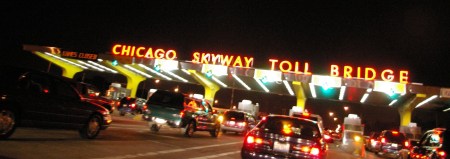Photo by Andrew Ciscel
There have been lots of good items on the ICC recently, mostly dealing with the ICC’s proposed tolling scheme. The City Fix DC looks at the rates:
The answer that’s been in the news lately is tolling. Tolls are planned for the Intercounty Connector (ICC), an 18.8-mile highway under construction between Gaithersburg and Laurel. To cover the road’s $2.56 billion construction cost, the Maryland Transportation Authority’s board has proposed rush-hour tolls of $.25 – $.35 per mile for 2-axle vehicles from 6:00 to 9:00 a.m. and 4:00 to 7:00 p.m. on weekdays. Off-peak rates for 2-axle vehicles would range from $.20 to $.30 per mile. The price tag would be around $11 roundtrip for the many drivers expected to use the ICC to commute between I-95 and I-270. The ICC tolling plan is getting a lot of press for proposing some of the highest rates in the country.
The City Fix notes that “on paper, the argument for road tolling is strong,” but doesn’t really address what kind of roads are being tolled, and at what rates. The ICC’s basic problem is that the tolls for that road are trying to finance the same road. Instead of tolling the congested roads around the ICC, using that toll to both manage traffic and raise revenue for more capacity, they’re leaving the congested routes free while tolling the new roads that have very little congestion.
In essence, they’re tolling the wrong road.
This isn’t a new revelation. In the Baltimore Sun, Michael Dresser says it was always meant to be like this:
Richard Landon of District Heights showed up to testify against any tolling. “We as taxpayers have already paid our share of taxes,” he said.
Actually, we haven’t.
At least, we haven’t paid enough to build a $2.6 billion, six-lane highway through suburban Washington. The toll road vs. freeway issue was decided during the Ehrlich administration with the acquiescence of the General Assembly. Neither wanted to put their necks on the line to raise gas taxes, which haven’t gone up since the early 1990s, to build the road as a freeway. It was either toll road or no road.
No free lunch.
The fact is that very few potential road links have the tolling potential to totally pay for themselves. Those kinds of roads are the key infrastructure we’ve traditionally paid for with tolls – key bridges and tunnels, for example – but that doesn’t really include second-tier suburban beltway links. We know this, yet we continue to punt the political football of actually paying for stuff.
This isn’t to say tolling is the wrong idea – it’s the right idea, but being used in the wrong place. Chris Bradford noted during NYC’s discussion of congestion pricing the stripped-down economic logic of using congestion tolls as a means of measuring demand for more capacity and then financing it:
But congestion pricing does more than relieve congestion. Congestion pricing tells us when a road needs more capacity. Additional capacity costs money, and drivers are willing to pay only so much for it. That “so much” is exactly equal to the price they are willing to pay to avoid congestion. When the revenue collected by congestion pricing is low — too low to finance new capacity — we know we have enough capacity. Drivers aren’t willing to pay for more, so building it would be wasteful.
On the other hand, If a properly priced road starts generating “too much” revenue — enough to cover the cost of expanding capacity — then it’s time to figure out how to add the capacity users are willing to pay for.
Instead of putting congestion pricing in place on the beltway and then determining if a) demand is there for the ICC and/or HOT lanes (since those lanes represent additional capacity); and b) if toll revenue is sufficient to pay for those expansions, we’ve instead gone ahead and will build the new lanes anyway, under the veneer that we can pay for them with tolls only on the new portions.
This doesn’t just apply to freeways, either. This works for any congested area.
Viewed properly, then, transit is simply a means for adding capacity. (Yes, I’m well aware of other arguments for transit, but I’m concentrating on the one that ought to appeal to the economics-inclined.)
The logic of congestion pricing, then, is that the old capacity is supposed to finance the construction and operation of the new capacity. Or to put it in the charged language that dominates transit debates, the old capacity is supposed to subsidize the new capacity. Indeed, if users had to pay “cost” for the new capacity, then too few would switch from the old road. That makes no sense because it creates the wrong incentives.
This does not mean the new capacity — whether road or transit — should be free. It should be congestion-priced, too. And as time goes by, the revenue raised thereby might cover the cost of operation and, in turn, finance even more capacity. But until that transpires, we shouldn’t insist that new capacity pay for itself.
Bold is mine. Insisting and expecting that we can get something for nothing because it will “pay for itself” isn’t a real solution. Road tolling programs need to be able to toll roads that are currently free to users, and they need to approach the issue through the lens of the entire transportation system.

